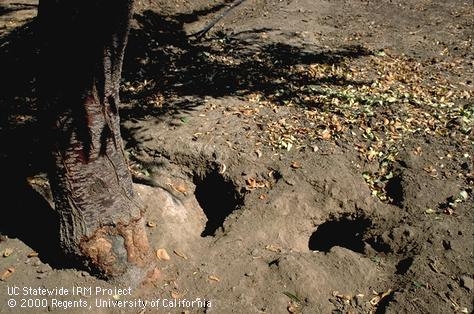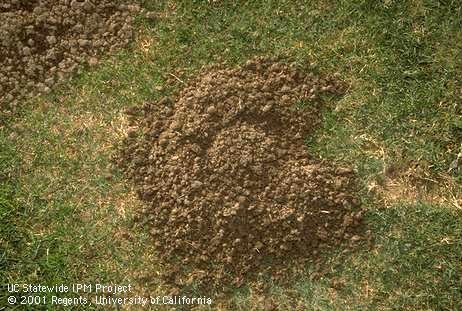Advice from the Help Desk of the
UC Master Gardener Program of Contra Costa County
Client: Some animal is burrowing throughout my garden. I've had pocket gophers in the past, but I'm not sure that's what I've got this time. Could you help me identify the “burrower” and suggest possible controls? Also, are these pests nocturnal?
MGPCC Help Desk: Thank you for contacting UC Master Gardeners of Contra Costa with your question regarding pest control of the burrowing pest(s) in your garden.
The potential pests in your yard could be ground squirrels, moles, pocket gophers or voles. You also mentioned that you have had pocket gophers in the past and wondered which of these critters are nocturnal.
All members of the squirrel family except flying squirrels are diurnal – which means they're active primarily during the day. Moles are not nocturnal. This misconception is probably the result of people looking out their window in the morning and seeing fresh mole hills. In fact, moles are not necessarily more or less active at any time during the day or night. They are more active during quiet periods, such as early morning or late in the evening. Pocket gophers are active throughout the day with periods of rest. Voles can be nocturnal or diurnal depending on the species.
The best way to determine what type of pest you have is by the damage you see.
- Ground Squirrels: The key identifier for these rodents is an exposed tunnel entrance with discarded dirt surrounding the entrance of the tunnel. You can see right into a ground squirrel burrow, unlike that of moles or pocket gophers.
- Moles: If you have a mole, you will see mounds of dirt and/or surface tunnels. Dirt mounds (look like piles or "puffs" of dirt shaped like a volcano) and surface tunnels (look like the veins on the back of your hand). Not all moles will have both surface tunnels and dirt mounds. If you see one or the other (or both), you have a mole.
- Pocket Gophers: Damage done by pocket gophers is similar to moles, but there is a major difference. Dirt mounds are crescent-shaped (like a "C") with a "dirt plug" on one side of the mound.
- Voles: Voles typically “piggy back” on the damage done by moles and tend to travel in mole tunnels and often are the cause of damage to roots, bulbs, and tubers within.




UC IPM Pest Notes (via free download) provide specific guidance on identification of these garden pests as well as controls. Here are the links to the appropriate Pest Notes:
Ground Squirrels:
http://www.ipm.ucdavis.edu/PMG/PESTNOTES/pn7438.html
Moles:
http://www.ipm.ucdavis.edu/PMG/PESTNOTES/pn74115.html
Pocket Gophers:
http://www.ipm.ucdavis.edu/PMG/PESTNOTES/pn7433.html
Voles:
http://www.ipm.ucdavis.edu/PMG/PESTNOTES/pn7439.html
Good luck on your on successful controls. You have many fellow gardeners who feel your pain.
Please do not hesitate to contact us if you have additional questions.
Help Desk of the UC Master Gardener Program of Contra Costa County (SLH)
Note: The UC Master Gardeners Program of Contra Costa's Help Desk is available year-round to answer your gardening questions. Except for a few holidays, we're open every week, Monday through Thursday for walk-ins from 9:00 am to Noon at 75 Santa Barbara Road, 2d Floor, Pleasant Hill, CA 94523. We can also be reached via telephone: (925) 646-6586, email: ccmg@ucanr.edu, or on the web at http://ccmg.ucanr.edu/Ask_Us/ MGCC Blogs can be found at http://ccmg.ucanr.edu/HortCoCo/ You can also subscribe to the Blog (//ucanr.edu/blogs/CCMGBlog/).